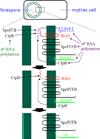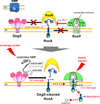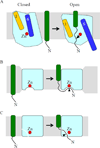Biochemical and structural insights into intramembrane metalloprotease mechanisms
- PMID: 24099006
- PMCID: PMC3793210
- DOI: 10.1016/j.bbamem.2013.03.032
Biochemical and structural insights into intramembrane metalloprotease mechanisms
Abstract
Intramembrane metalloproteases are nearly ubiquitous in living organisms and they function in diverse processes ranging from cholesterol homeostasis and the unfolded protein response in humans to sporulation, stress responses, and virulence of bacteria. Understanding how these enzymes function in membranes is a challenge of fundamental interest with potential applications if modulators can be devised. Progress is described toward a mechanistic understanding, based primarily on molecular genetic and biochemical studies of human S2P and bacterial SpoIVFB and RseP, and on the structure of the membrane domain of an archaeal enzyme. Conserved features of the enzymes appear to include transmembrane helices and loops around the active site zinc ion, which may be near the membrane surface. Extramembrane domains such as PDZ (PSD-95, DLG, ZO-1) or CBS (cystathionine-β-synthase) domains govern substrate access to the active site, but several different mechanisms of access and cleavage site selection can be envisioned, which might differ depending on the substrate and the enzyme. More work is needed to distinguish between these mechanisms, both for enzymes that have been relatively well-studied, and for enzymes lacking PDZ and CBS domains, which have not been studied. This article is part of a Special Issue entitled: Intramembrane Proteases.
Keywords: (PSD-95, DLG, ZO-1); (cystathionine-β-synthase); CBS; CBS domain; GFP; IMMP(s); IP(s); Intramembrane metalloprotease; OMP(s); PDZ; PDZ domain; RNA polymerase; RNAP; RseP; S1P; S2P; SCAP; SREBP(s); SREBP-cleavage-activating protein; SpoIVFB; TMS(s); green fluorescent protein; intramembrane metalloprotease(s); intramembrane protease(s); outer membrane protein(s); site-1 protease; site-2 protease; sterol-regulatory element-binding protein(s); transmembrane segment(s).
Copyright © 2013 Elsevier B.V. All rights reserved.
Figures








Similar articles
-
Conserved Proline Residues of Bacillus subtilis Intramembrane Metalloprotease SpoIVFB Are Important for Substrate Interaction and Cleavage.J Bacteriol. 2022 Mar 15;204(3):e0038621. doi: 10.1128/JB.00386-21. Epub 2022 Jan 10. J Bacteriol. 2022. PMID: 35007155 Free PMC article.
-
Residues in conserved loops of intramembrane metalloprotease SpoIVFB interact with residues near the cleavage site in pro-σK.J Bacteriol. 2013 Nov;195(21):4936-46. doi: 10.1128/JB.00807-13. Epub 2013 Aug 30. J Bacteriol. 2013. PMID: 23995631 Free PMC article.
-
Inhibitory proteins block substrate access by occupying the active site cleft of Bacillus subtilis intramembrane protease SpoIVFB.Elife. 2022 Apr 26;11:e74275. doi: 10.7554/eLife.74275. Elife. 2022. PMID: 35471152 Free PMC article.
-
Structural and mechanistic principles of intramembrane proteolysis--lessons from rhomboids.FEBS J. 2013 Apr;280(7):1579-603. doi: 10.1111/febs.12199. Epub 2013 Mar 20. FEBS J. 2013. PMID: 23432912 Review.
-
New insights into S2P signaling cascades: regulation, variation, and conservation.Protein Sci. 2010 Nov;19(11):2015-30. doi: 10.1002/pro.496. Protein Sci. 2010. PMID: 20836086 Free PMC article. Review.
Cited by
-
S2P intramembrane protease RseP degrades small membrane proteins and suppresses the cytotoxicity of intrinsic toxin HokB.mBio. 2023 Aug 31;14(4):e0108623. doi: 10.1128/mbio.01086-23. Epub 2023 Jul 6. mBio. 2023. PMID: 37409810 Free PMC article.
-
Evidence that regulation of intramembrane proteolysis is mediated by substrate gating during sporulation in Bacillus subtilis.PLoS Genet. 2018 Nov 7;14(11):e1007753. doi: 10.1371/journal.pgen.1007753. eCollection 2018 Nov. PLoS Genet. 2018. PMID: 30403663 Free PMC article.
-
Two Metalloproteases VdM35-1 and VdASPF2 from Verticillium dahliae Are Required for Fungal Pathogenicity, Stress Adaptation, and Activating Immune Response of Host.Microbiol Spectr. 2022 Dec 21;10(6):e0247722. doi: 10.1128/spectrum.02477-22. Epub 2022 Oct 12. Microbiol Spectr. 2022. PMID: 36222688 Free PMC article.
-
Role of Regulated Proteolysis in the Communication of Bacteria With the Environment.Front Mol Biosci. 2020 Oct 15;7:586497. doi: 10.3389/fmolb.2020.586497. eCollection 2020. Front Mol Biosci. 2020. PMID: 33195433 Free PMC article. Review.
-
Cleavage cascade of the sigma regulator FecR orchestrates TonB-dependent signal transduction.Proc Natl Acad Sci U S A. 2025 Apr 22;122(16):e2500366122. doi: 10.1073/pnas.2500366122. Epub 2025 Apr 17. Proc Natl Acad Sci U S A. 2025. PMID: 40244679
References
-
- Rawson R, Zelenski N, Nijhawan D, Ye J, Sakai J, Hasan M, Chang T, Brown M, Goldstein J. Complementation cloning of SP2, a gene encoding a putative metalloprotease required for intramembrane cleavage of SREBPs. Mol. Cell. 1997;1:47–57. - PubMed
Publication types
MeSH terms
Substances
Grants and funding
LinkOut - more resources
Full Text Sources
Other Literature Sources
Molecular Biology Databases

